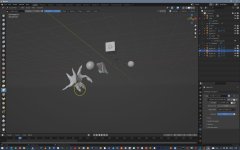@Axis3d Is there a reason why you are appending instead of linking? Linking is more or less the same behaviour as pointing to an object in LW's scene files. Appending is duplicating the original scene/object/material/etc. into your master file, which is generally something to avoid, in my opinion, because your scene file(s) will quickly balloon into file sizes that reach dizzying heights

The 'master' scene file in Blender only increases by a couple of kilobytes when linking an object.
The trick is to create a collection in the object file, put the object(s) in that collection and then link to it in the master scene file.
Materials can also be linked, as can other parts of a Blender file, btw.
To simplify life, activate the Edit Linked Library addon, which enables a workflow that is similar to Layout and Modeler. A simple click opens the selected linked object either in the same instance of Blender, or in a separate instance. Then edit the object, and return to the master scene with one click. Very handy and I use that addon all the time.
It is also possible to reload a linked blend file by switching the Outliner to "Blender File" and right-clicking the external blend file entry --> Reload.
As for the reason why a Blender file takes up more space: it's not really a file format at all. It is basically a memory dump with a file header and DNA (structure info). There is no translation or interpretation going on - which also explains why blend files load up so quickly. An additional advantage is that the state of the application is saved as well - continue where you left off when you last saved it. (loading the UI can be avoided though via FIle-->Open, N-->Load UI).
The developer of Accutrans (a 3d file format expert) looked into supporting *.blend files, but quickly found out that it is not a typical file format.
And a basic cube file in Blender also includes the default brushes, the light, the camera, and the workspace entries. If these are removed and the file is compressed the total file size for a cube is decreased to 81.3kb - if the file thumbnail is omitted 77.9 kb.
The differences in file size become less obvious in larger projects that are properly linked in Blender (as long as compression is turned on).
PS Cinema4D creates a file of 183kb for a simple cube mesh. Haven't tested Max or Maya, but I'd be surprised if file sizes were any smaller than that.





